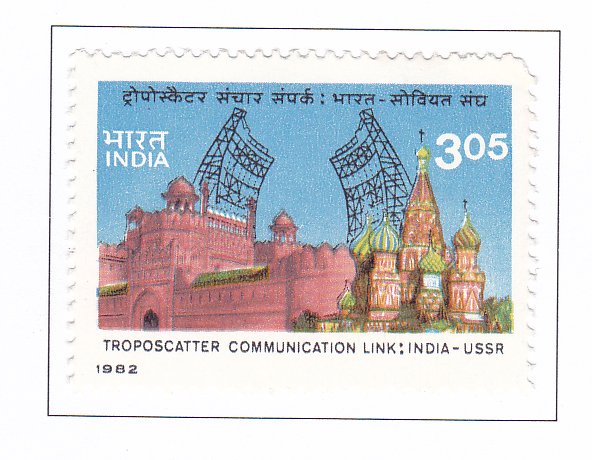1st Anniversary of Troposcatter Communication Link

Technical Data
| Date of Issue | November 2, 1982 |
|---|---|
| Denomination | Rs. 3.05 |
| Quantity | 2,000,000 |
| Perforation | comb 13 |
| Printer | Security Printing Press, Nashik |
| Watermark | No Watermark |
| Colors | Multicolor |
| Catalog Codes |
Michel IN 923 Stamp Number IN 994 Yvert et Tellier IN 733 Stanley Gibbons IN 1058 |
| Themes | Anniversaries and Jubilees | Buildings | Communication |
On November 2, 1981, a unique troposcatter communication link between India and the USSR was inaugurated by the Prime Minister of India. This link operates on the principle of propagating radio waves through the tropospheric medium over long distances, facilitating telecommunication between the two countries.
Technical Overview
The Indian station for this link is located at Charar-e-Sherief near Srinagar, while the USSR station is situated near Dushanbe in the Tadzik Republic. The path between these two stations spans approximately 685 kilometers, crossing high mountainous terrain. The transmitting antenna from each station emits a radio beam that hits mountain ridges along the route. A portion of the beam’s energy is diffracted or bent towards the distant terminal, allowing communication between the stations.
Signal Propagation and Compensation
As the radio beam travels through the atmosphere, it encounters atmospheric inhomogeneities that diminish the signal strength. To compensate for this, frequency and space diversity techniques are employed. This process derives four received signals, which are then combined using special techniques to produce a steady and reliable signal for high-quality communication.
Infrastructure and Equipment
At Charar-e-Sherief, the station uses two large parabolic billboard-type antennas, each measuring 30 meters square, for signal transmission and reception. The Electronic Corporation of India Ltd. (ECIL) designed, fabricated, and installed these antennas and supplied similar structures for the Dushanbe station. The link operates on the 800 MHz and 900 MHz bands, with a transmitted power of 10 kW on each of the two frequencies in both directions. The radio equipment was provided by the USSR.
Connectivity and Capacity
The international link extends from Dushanbe to Moscow and from Srinagar to New Delhi via the national systems of the two countries. The link has a capacity of 12 telephone channels, designed to accommodate future traffic requirements. Over the past year, the link has demonstrated its capability to span great distances and navigate formidable mountainous terrain using troposphere techniques.
Commemoration
To celebrate the first anniversary of this pioneering telecommunication link, the Indian Posts and Telegraphs Department issued a commemorative stamp. This stamp marks the significance of the troposcatter communication link, highlighting the technological collaboration between India and the USSR and their advancements in overcoming geographical challenges for effective communication.
